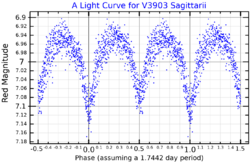Astronomy:V3903 Sagittarii
| Observation data Equinox J2000.0]] (ICRS) | |
|---|---|
| Constellation | Sagittarius |
| Right ascension | 18h 09m 17.6999s[2] |
| Declination | −23° 59′ 18.2312″ |
| Apparent magnitude (V) | 7.00–7.45[3] |
| Characteristics | |
| Spectral type | O7V(n)z + B0:V:[4] |
| U−B color index | −0.82[5] |
| B−V color index | +0.16[5] |
| Variable type | Algol[6] |
| Astrometry | |
| Proper motion (μ) | RA: +0.87±0.67[7] mas/yr Dec.: −0.66±0.42[7] mas/yr |
| Parallax (π) | 0.8368 ± 0.0258[8] mas |
| Distance | 3,900 ± 100 ly (1,200 ± 40 pc) |
| Absolute magnitude (MV) | −4.59 + −3.69[6] |
| Orbit[6] | |
| Period (P) | 1.744204 days |
| Eccentricity (e) | 0 |
| Inclination (i) | 65.20° |
| Semi-amplitude (K1) (primary) | 236.6 km/s |
| Semi-amplitude (K2) (secondary) | 339.4 km/s |
| Details[6] | |
| A | |
| Mass | 27.27 M☉ |
| Radius | 8.088 R☉ |
| Luminosity | 122,000 L☉ |
| Surface gravity (log g) | 4.058 cgs |
| Temperature | 38,000 K |
| Rotational velocity (v sin i) | 230 km/s |
| B | |
| Mass | 19.01 M☉ |
| Radius | 6.125 R☉ |
| Luminosity | 45,500 L☉ |
| Surface gravity (log g) | 4.143 cgs |
| Temperature | 34,100 K |
| Rotational velocity (v sin i) | 170 km/s |
| Age | 1.6 Myr |
| Other designations | |
| Database references | |
| SIMBAD | data |
V3903 Sagittarii (also known as 11 Sagittarii, or its abbreviation 11 Sgr) is an eclipsing binary star system in the constellation Sagittiarus. It creates an H II region LBN 29 (Sh 2-29) 1,070 parsecs (3,500 light-years) away from the Sun.[9]
John Flamsteed designated this star the Flamsteed designation 11 Sagittarii, although the designation 11 Sgr is now more often used to refer to the star he designated 1 Sagittarii.[10]
Properties
The system consists of two hot main-sequence stars. The spectral types have historically been accepted as O7V and O9V,[11] but the more recent Galactic O-Star Spectroscopic Survey gives a spectral type of O7V(n)z + B0:V:.[4] The system is one of the youngest-known eclipsing binaries, and one of the few containing such massive stars that have not yet filled their roche lobes. Their likely age is around 1.6 million years, and they have current masses of 27 M☉ and 19 M☉.[6]
V3903 Sagittarii varies in brightness. The General Catalogue of Variable Stars lists it as a possible hot irregular Orion variable star, but it has been shown to be a detached eclipsing binary system. The two stars are detached, that is they do not fill their roche lobes, which makes it an Algol-type eclipsing variable. The period is one day, 18 hours, 52 minutes.[11][6]
The distance derived from the annual parallax measured by the Hipparcos satellite is around 459 parsecs (1,500 ly),[7] but the distance calculated from the physical properties of the two stars is 1,500 pc.[6] Later measurements have resulted in refined distances estimates of 1,070 pc[9] and 1,200 pc.[8]
References
- ↑ Wraight, K. T.; White, Glenn J.; Bewsher, D.; Norton, A. J. (October 2011). "STEREO observations of stars and the search for exoplanets". Monthly Notices of the Royal Astronomical Society 416 (4): 2477–2493. doi:10.1111/j.1365-2966.2011.18599.x. Bibcode: 2011MNRAS.416.2477W. https://ui.adsabs.harvard.edu/abs/2011MNRAS.416.2477W. Retrieved 9 March 2022.
- ↑ Brown, A. G. A. (August 2018). "Gaia Data Release 2: Summary of the contents and survey properties". Astronomy & Astrophysics 616: A1. doi:10.1051/0004-6361/201833051. Bibcode: 2018A&A...616A...1G. Gaia DR2 record for this source at VizieR.
- ↑ Samus, N. N. et al. (2009). "VizieR Online Data Catalog: General Catalogue of Variable Stars (Samus+ 2007-2013)". VizieR On-line Data Catalog: B/GCVS. Originally Published in: 2009yCat....102025S 1. Bibcode: 2009yCat....102025S.
- ↑ 4.0 4.1 Sota, A.; Maíz Apellániz, J.; Morrell, N. I.; Barbá, R. H.; Walborn, N. R.; Gamen, R. C.; Arias, J. I.; Alfaro, E. J. (2014). "The Galactic O-Star Spectroscopic Survey (GOSSS). II. Bright Southern Stars". The Astrophysical Journal Supplement 211 (1): 10. doi:10.1088/0067-0049/211/1/10. Bibcode: 2014ApJS..211...10S.
- ↑ 5.0 5.1 Schild, R. E.; Garrison, R. F.; Hiltner, W. A. (1983). "UBV photometry for southern OB stars". Astrophysical Journal Supplement Series 51: 321. doi:10.1086/190852. Bibcode: 1983ApJS...51..321S.
- ↑ 6.0 6.1 6.2 6.3 6.4 6.5 6.6 Vaz, L. P. R.; Cunha, N. C. S.; Vieira, E. F.; Myrrha, M. L. M. (1997). "V 3903 Sagittarii: A massive main-sequence (O7V+O9V) detached eclipsing binary". Astronomy and Astrophysics 327: 1094. Bibcode: 1997A&A...327.1094V.
- ↑ 7.0 7.1 7.2 van Leeuwen, F. (2007). "Validation of the new Hipparcos reduction". Astronomy and Astrophysics 474 (2): 653–664. doi:10.1051/0004-6361:20078357. Bibcode: 2007A&A...474..653V.
- ↑ 8.0 8.1 Brown, A. G. A. (2021). "Gaia Early Data Release 3: Summary of the contents and survey properties". Astronomy & Astrophysics 649: A1. doi:10.1051/0004-6361/202039657. Bibcode: 2021A&A...649A...1G. Gaia EDR3 record for this source at VizieR.
- ↑ 9.0 9.1 Arellano-Córdova, K. Z.; Esteban, C.; García-Rojas, J.; Méndez-Delgado, J. E. (2021), "On the radial abundance gradients of nitrogen and oxygen in the inner Galactic disc", Monthly Notices of the Royal Astronomical Society 502: 225–241, doi:10.1093/mnras/staa3903
- ↑ Wagman, M. (1987). "Flamsteed's Missing Stars". Journal for the History of Astronomy 18 (3): 209–223. doi:10.1177/002182868701800305. Bibcode: 1987JHA....18..209W.
- ↑ 11.0 11.1 Weidner, C. (2010). "The masses, and the mass discrepancy of O-type stars". Astronomy & Astrophysics 524: A98. doi:10.1051/0004-6361/201014491. Bibcode: 2010A&A...524A..98W.
 |


